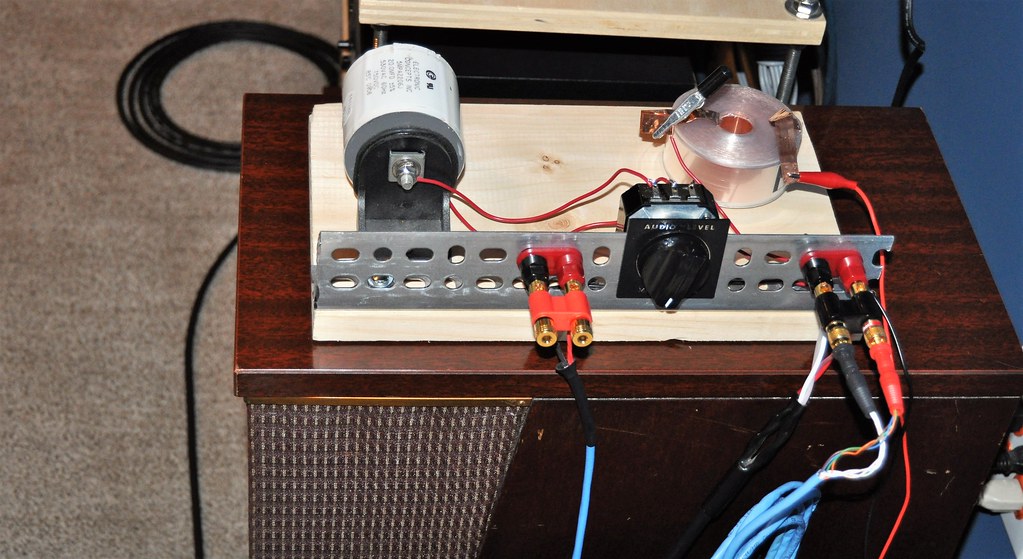You are using an out of date browser. It may not display this or other websites correctly.
You should upgrade or use an alternative browser.
You should upgrade or use an alternative browser.
Post pics of crossovers
- Thread starter Tom Bombadil
- Start date
mroboto
Super Member
One of the best speakers I ever had was 12" woofers direct on amplifier like a full range, with a 8" driver connnected in parallel using 30uf (3x10uf) PIO caps for LF filter , and a dome tweeter connected in parallel with the 8" driver with a 4uf PIO cap for LF filter.
So, everything is in phase 0°.
So, everything is in phase 0°.
Last edited:
KrautNotRice
Well-Known Member
A non traditional crossover in the simplest form is this single cap on the B&G planar tweeter's + terminal. It blocks the LF signal while passing the HF signal. Requires trying a variety of caps to find the right value.
View attachment 1288983
I bet that cap just zaps all the life right out of that planar...
I really like my Ashly XR-1001 electronic crossover, but found that some (MANY) drivers sound way better with at least some basic passive filters also, like impedance correction at the minimum, even if using an electronic x/o.
Blue Shadow
Waiting for Vintage Gear from this century
Blue Shadow
Waiting for Vintage Gear from this century
I always thought crossovers that used bulbs to protect tweeters should have been displayed in a little window.View attachment 1289127
Norman 10B, got a recap last year at John's house.
Blue Shadow
Waiting for Vintage Gear from this century
Like the tubes used in the Luxman Brid-series of amps.I always thought crossovers that used bulbs to protect tweeters should have been displayed in a little window.
The problem with the viewing of the bulbs is that the customer doesn't know it and then when the bulb lights for the first time the get all worried and the phone starts to ring. Hi-Fi House, 1979 or 80, Bose 301 with the light flashing out the port of the speakers.
True, but for me it would alert me to over driving the speaker. It could have been marketed as a visual aid for the customer. But then I guess you would get those people that might push them just to see the bulb get bright.Like the tubes used in the Luxman Brid-series of amps.
The problem with the viewing of the bulbs is that the customer doesn't know it and then when the bulb lights for the first time the get all worried and the phone starts to ring. Hi-Fi House, 1979 or 80, Bose 301 with the light flashing out the port of the speakers.
Poultrygeist
Lunatic Member
I bet that cap just zaps all the life right out of that planar...
I really like my Ashly XR-1001 electronic crossover, but found that some (MANY) drivers sound way better with at least some basic passive filters also, like impedance correction at the minimum, even if using an electronic x/o.
My Ashly XR-1001 is on the 3rd shelf but I only use it for the LF woofer and sub crossovers. When I tried it with the tube amp powered Lowthers it killed the magic.
Attachments
Blue Shadow
Waiting for Vintage Gear from this century
The light bulb wasn't marketed as anything but tweeter protection. Not many saw the light flash but those that did were concerned because there wasn't a mention of it, I don't think, in any literature. The bulb does its job, especially when lighting up, sucking power that won't then go to the tweeter, protecting the tweeter. Not special reason to turn it down on light up. The more it is driven, the more it lights, the more power sucked up by the light.
mhardy6647
Lunatic Member
 DSC_9782 (3) by Mark Hardy, on Flickr
DSC_9782 (3) by Mark Hardy, on FlickrPoultrygeist
Lunatic Member
Realizing there's no getting around passives for many applications nevertheless here are a couple of interesting articles on the subject.
https://audiophilereview.com/reference-speakers/crossovers-are-evil.html
https://www.xkitz.com/blogs/making-...g-the-case-for-active-crossovers-vs-passive-1
https://audiophilereview.com/reference-speakers/crossovers-are-evil.html
https://www.xkitz.com/blogs/making-...g-the-case-for-active-crossovers-vs-passive-1
mhardy6647
Lunatic Member
 EV XOs by Mark Hardy, on Flickr
EV XOs by Mark Hardy, on FlickrBlue Shadow
Waiting for Vintage Gear from this century

Magneplanar external crossovers for the MG-III. These speakers have two crossovers, one external and one internal. The external is too big to put into the speaker so some of their speakers have external crossovers, too.
I guessing these are the only finished component ones so far posted that don't plug into the wall like all those electronic crossovers. I see some other crossovers used outside the speaker. The one by Mark looks to be easily adjusted.
Markoneswift
Quartz locked n ready to rock
Similar threads
- Replies
- 36
- Views
- 1K
- Replies
- 1
- Views
- 300
- Replies
- 31
- Views
- 2K














